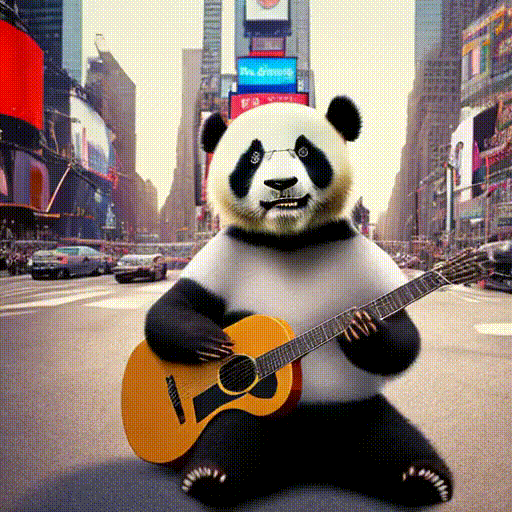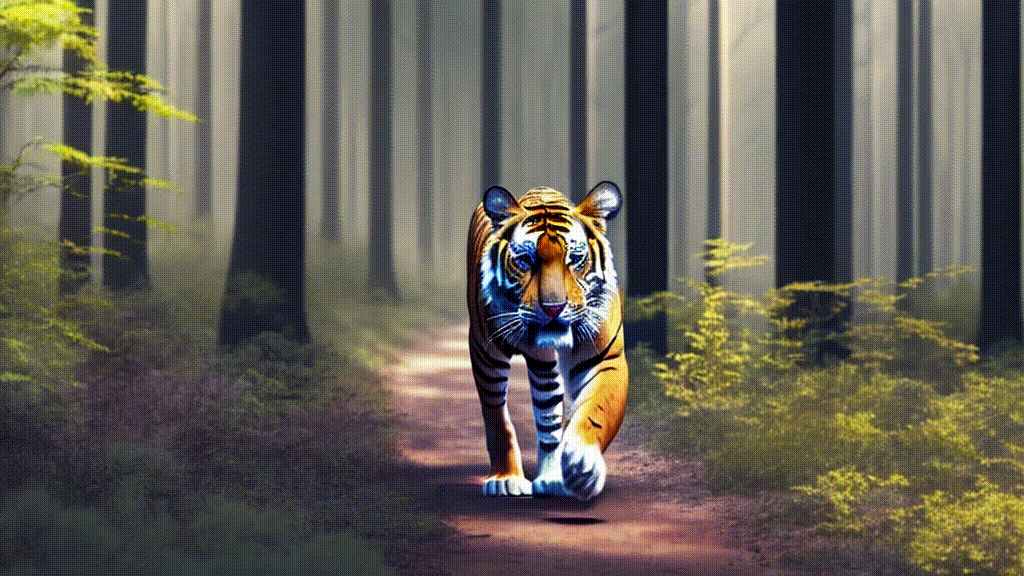text2video-zero-openjourney
Maintainer: wcarle

13

| Property | Value |
|---|---|
| Run this model | Run on Replicate |
| API spec | View on Replicate |
| Github link | View on Github |
| Paper link | View on Arxiv |
Create account to get full access
Model overview
The text2video-zero-openjourney model, developed by Picsart AI Research, is a groundbreaking AI model that enables zero-shot video generation using text prompts. It leverages the power of existing text-to-image synthesis methods, such as Stable Diffusion, and adapts them for the video domain. This innovative approach allows users to generate dynamic, temporally consistent videos directly from textual descriptions, without the need for additional training on video data.
Model inputs and outputs
The text2video-zero-openjourney model takes in a text prompt as input and generates a video as output. The model can also be conditioned on additional inputs, such as poses or edges, to guide the video generation process.
Inputs
- Prompt: A textual description of the desired video content, such as "A panda is playing guitar on Times Square".
- Pose Guidance: An optional input in the form of a video containing poses that can be used to guide the video generation.
- Edge Guidance: An optional input in the form of a video containing edge information that can be used to guide the video generation.
- Dreambooth Specialization: An optional input in the form of a Dreambooth-trained model, which can be used to generate videos with a specific style or character.
Outputs
- Video: The generated video, which follows the provided textual prompt and any additional guidance inputs.
Capabilities
The text2video-zero-openjourney model is capable of generating a wide variety of dynamic video content, ranging from animals performing actions to fantastical scenes with anthropomorphized characters. For example, the model can generate videos of "A horse galloping on a street", "An astronaut dancing in outer space", or "A panda surfing on a wakeboard".
What can I use it for?
The text2video-zero-openjourney model opens up exciting possibilities for content creation and storytelling. Creators and artists can use this model to quickly generate unique video content for various applications, such as social media, animation, and filmmaking. Businesses can leverage the model to create dynamic, personalized video advertisements or product demonstrations. Educators and researchers can explore the model's capabilities for educational content and data visualization.
Things to try
One interesting aspect of the text2video-zero-openjourney model is its ability to incorporate additional guidance inputs, such as poses and edges. By providing these inputs, users can further influence the generated videos and achieve specific visual styles or narratives. For example, users can generate videos of "An alien dancing under a flying saucer" by providing a video of dancing poses as guidance.
Another fascinating capability of the model is its integration with Dreambooth specialization. By fine-tuning the model with a Dreambooth-trained model, users can generate videos with a distinct visual style or character, such as "A GTA-5 man" or "An Arcane-style character".
This summary was produced with help from an AI and may contain inaccuracies - check out the links to read the original source documents!
Related Models

text2video-zero

2
text2video-zero is a novel AI model developed by researchers at Picsart AI Research that leverages the power of existing text-to-image synthesis methods, like Stable Diffusion, to generate high-quality video content from text prompts. Unlike previous video generation models that relied on complex frameworks, text2video-zero can produce temporally consistent videos in a zero-shot manner, without the need for any video-specific training. The model also supports various conditional inputs, such as poses, edges, and Dreambooth specialization, to further guide the video generation process. Model inputs and outputs text2video-zero takes a textual prompt as input and generates a video as output. The model can also leverage additional inputs like poses, edges, and Dreambooth specialization to provide more fine-grained control over the generated videos. Inputs Prompt**: A textual description of the desired video content. Pose/Edge guidance**: Optional input video that provides pose or edge information to guide the video generation. Dreambooth specialization**: Optional input that specifies a Dreambooth model to apply specialized visual styles to the generated video. Outputs Video**: The generated video that matches the input prompt and any additional guidance provided. Capabilities text2video-zero can generate a wide range of video content, from simple scenes like "a cat running on the grass" to more complex and dynamic ones like "an astronaut dancing in outer space." The model is capable of producing temporally consistent videos that closely follow the provided textual prompts and guidance. What can I use it for? text2video-zero can be used to create a variety of video content for various applications, such as: Content creation**: Generate unique and customized video content for social media, marketing, or entertainment purposes. Prototyping and storyboarding**: Quickly generate video previews to explore ideas and concepts before investing in more costly production. Educational and informational videos**: Generate explanatory or instructional videos on a wide range of topics. Video editing and manipulation**: Use the model's conditional inputs to edit or manipulate existing video footage. Things to try Some interesting things to try with text2video-zero include: Experiment with different textual prompts to see the range of video content the model can generate. Explore the use of pose, edge, and Dreambooth guidance to refine and personalize the generated videos. Try using the model's low-memory setup to generate videos on hardware with limited GPU memory. Integrate text2video-zero into your own projects or workflows to enhance your video creation capabilities.
Updated Invalid Date
⛏️
text2video-zero

40
The text2video-zero model, developed by cjwbw from Picsart AI Research, leverages the power of existing text-to-image synthesis methods, like Stable Diffusion, to enable zero-shot video generation. This means the model can generate videos directly from text prompts without any additional training or fine-tuning. The model is capable of producing temporally consistent videos that closely follow the provided textual guidance. The text2video-zero model is related to other text-guided diffusion models like Clip-Guided Diffusion and TextDiffuser, which explore various techniques for using diffusion models as text-to-image and text-to-video generators. Model Inputs and Outputs Inputs Prompt**: The textual description of the desired video content. Model Name**: The Stable Diffusion model to use as the base for video generation. Timestep T0 and T1**: The range of DDPM steps to perform, controlling the level of variance between frames. Motion Field Strength X and Y**: Parameters that control the amount of motion applied to the generated frames. Video Length**: The desired duration of the output video. Seed**: An optional random seed to ensure reproducibility. Outputs Video**: The generated video file based on the provided prompt and parameters. Capabilities The text2video-zero model can generate a wide variety of videos from text prompts, including scenes with animals, people, and fantastical elements. For example, it can produce videos of "a horse galloping on a street", "a panda surfing on a wakeboard", or "an astronaut dancing in outer space". The model is able to capture the movement and dynamics of the described scenes, resulting in temporally consistent and visually compelling videos. What can I use it for? The text2video-zero model can be useful for a variety of applications, such as: Generating video content for social media, marketing, or entertainment purposes. Prototyping and visualizing ideas or concepts that can be described in text form. Experimenting with creative video generation and exploring the boundaries of what is possible with AI-powered video synthesis. Things to try One interesting aspect of the text2video-zero model is its ability to incorporate additional guidance, such as poses or edges, to further influence the generated video. By providing a reference video or image with canny edges, the model can generate videos that closely follow the visual structure of the guidance, while still adhering to the textual prompt. Another intriguing feature is the model's support for Dreambooth specialization, which allows you to fine-tune the model on a specific visual style or character. This can be used to generate videos that have a distinct artistic or stylistic flair, such as "an astronaut dancing in the style of Van Gogh's Starry Night".
Updated Invalid Date

videocrafter

28
VideoCrafter is an open-source video generation and editing toolbox created by cjwbw, known for developing models like voicecraft, animagine-xl-3.1, video-retalking, and tokenflow. The latest version, VideoCrafter2, overcomes data limitations to generate high-quality videos from text or images. Model inputs and outputs VideoCrafter2 allows users to generate videos from text prompts or input images. The model takes in a text prompt, a seed value, denoising steps, and guidance scale as inputs, and outputs a video file. Inputs Prompt**: A text description of the video to be generated. Seed**: A random seed value to control the output video generation. Ddim Steps**: The number of denoising steps in the diffusion process. Unconditional Guidance Scale**: The classifier-free guidance scale, which controls the balance between the text prompt and unconditional generation. Outputs Video File**: A generated video file that corresponds to the provided text prompt or input image. Capabilities VideoCrafter2 can generate a wide variety of high-quality videos from text prompts, including scenes with people, animals, and abstract concepts. The model also supports image-to-video generation, allowing users to create dynamic videos from static images. What can I use it for? VideoCrafter2 can be used for various creative and practical applications, such as generating promotional videos, creating animated content, and augmenting video production workflows. The model's ability to generate videos from text or images can be especially useful for content creators, marketers, and storytellers who want to bring their ideas to life in a visually engaging way. Things to try Experiment with different text prompts to see the diverse range of videos VideoCrafter2 can generate. Try combining different concepts, styles, and settings to push the boundaries of what the model can create. You can also explore the image-to-video capabilities by providing various input images and observing how the model translates them into dynamic videos.
Updated Invalid Date

zero-shot-image-to-text

6
The zero-shot-image-to-text model is a cutting-edge AI model designed for the task of generating text descriptions from input images. Developed by researcher yoadtew, this model leverages a unique "zero-shot" approach to enable image-to-text generation without the need for task-specific fine-tuning. This sets it apart from similar models like stable-diffusion, uform-gen, and turbo-enigma which often require extensive fine-tuning for specific image-to-text tasks. Model inputs and outputs The zero-shot-image-to-text model takes in an image and produces a text description of that image. The model can handle a wide range of image types and subjects, from natural scenes to abstract concepts. Additionally, the model supports "visual-semantic arithmetic" - the ability to perform arithmetic operations on visual concepts to generate new images. Inputs Image**: The input image to be described Outputs Text Description**: A textual description of the input image Capabilities The zero-shot-image-to-text model has demonstrated impressive capabilities in generating detailed and coherent image descriptions across a diverse set of visual inputs. It can handle not only common objects and scenes, but also more complex visual reasoning tasks like understanding visual relationships and analogies. What can I use it for? The zero-shot-image-to-text model can be a valuable tool for a variety of applications, such as: Automated Image Captioning**: Generating descriptive captions for large image datasets, which can be useful for tasks like visual search, content moderation, and accessibility. Visual Question Answering**: Answering questions about the contents of an image, which can be helpful for building intelligent assistants or educational applications. Visual-Semantic Arithmetic**: Exploring and manipulating visual concepts in novel ways, which can inspire new creative applications or research directions. Things to try One interesting aspect of the zero-shot-image-to-text model is its ability to handle "visual-semantic arithmetic" - the ability to combine visual concepts in arithmetic-like operations to generate new, semantically meaningful images. For example, the model can take in images of a "woman", a "king", and a "man", and then generate a new image that represents the visual concept of "woman - king + man". This opens up fascinating possibilities for exploring the relationships between visual and semantic representations.
Updated Invalid Date